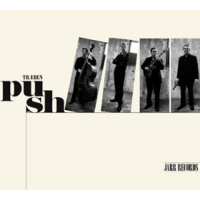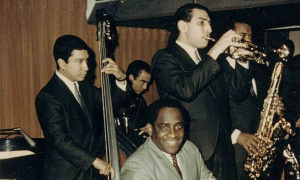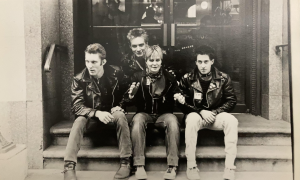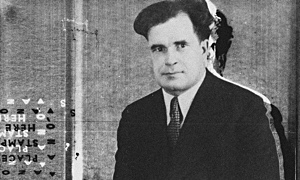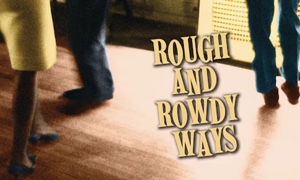Home » Jazz Articles » Hardly Strictly Jazz » A Few Frames Of Public Access Art
A Few Frames Of Public Access Art
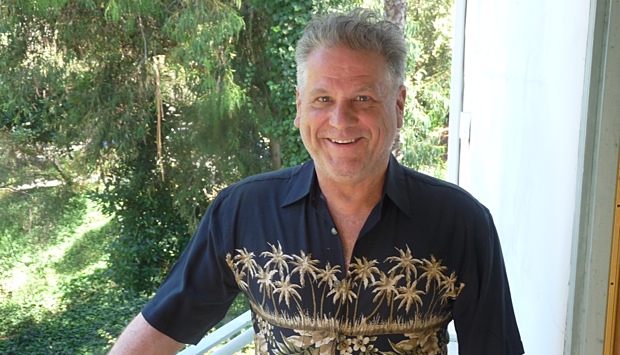
Growing up in Philly in the 1970s, "big" music televison was (for me) Soul Train, Don Kirchner's Rock Concert and Midnight Special. But also—and no less important—there were the Saturday night syndicated 30 minute low budget country shows that featured guests playing live with a house band. Nobody lipsynched on The Wilburn Brothers Show, Pop Goes The Country and The Porter Wagoner Show. Or Hee Haw. And those crews knew how to shoot musicians.
The best, coolest show ever was Art Fein's Poker Party, a music talk show that ran from 1984 through 2008 on Los Angeles public access cable. A real live Wayne's World, shot at local LA public access studios for $35 an episode. Art Fein—author, journalist, self-taught historian, promotor, record company employee, band manager (the Cramps), Bluzblasters)—hosted 1200+ 30 minute episodes, and the guest list is staggering, including Joe Strummer, Dwight Yoakum, Brian Wilson, Alison Krauss, Screamin' Jay Hawkins, Bluzblasters, Ike Turner, Dr Demento, Brian Setzer and many other similarly famous figures. The behind-the-scenes stars were just as prominent—producers, engineers, managers and songwriters. The atmosphere of the show was always informal and chatty, even Runyonesque. It was a table full of rock'n'roll wiseguys. Except these guys talked about Phil Spector, not Joe Louis. The show also featured some exquisite live stripped down acoustic performances years before anyone at MTV unplugged anything. Art Fein figured out how to get the musicmakers on TV, informally telling their stories, playing the songs, and just being who they were. At 1200 thirty minute episodes. It is an archive that rivals that of Alan Lomax.
It could only have happened here. This is where so many of the musicmakers settled, and where so many of the evolutions—not just in musical style, but in technology and attitude as well—took place. And the guys who helped make it happen love to talk about their respective roles. So Art Fein got them talking about their hits and misses, what happened and what they wished had happened. Watching them speak brings to mind what Carey McWilliams wrote in his 1946 masterpiece Southern California: An Island On The Land: "This land is not merely a testing ground, it is also a forcing ground, a place where ideas, practices, and customs must prove their worth or be discarded."
Art Fein did not design his show to be a major archival document. I am being diplomatic.
"I had a weekly card game, and nobody could really play cards," Art said as we watched video of Jerry Lee Lewis in his study, "So I just went to the public access studio and had my card game on camera. I am not a public speaker or an emcee, so the format of the show was just like you and I now, talking about music, except with a couple of cameramen. The first show was that, all the shows were pretty much that.
"We (the creators of the shows) were just sort of disdained by everybody who worked at the public access studios. A lot of the shows were just boring people acting kind of dumb on camera. Nobody wanted to see it, so I thought, 'Why not?' and just started doing the show."
Word of the show spread beyond Los Angeles. Andy Warhol's Interview magazine even ran a small piece about it, and VHS copies started finding their way into the hands of collectors all over the country, often with fans in other cities renting time on their local public access stations to air the show in their own town. There was something of a fan network emerging in those pre-internet days, and Art serviced these folks almost as if they were paying subscribers, sending out copies (dubbed in real time on a home-rigged system of several VHS machines wired together), often by the boxload. Art Fein had carved out a place as a credible historian by the time Faber & Faber published his 1990 book, The L.A. Musical History Tour.
Great book, too. I had bought it three years before I moved to Los Angeles, and read it several times before I ever met Art Fein. When we met, around 1997, I immediately told him I knew the book, and how much I'd enjoyed it. We spent the rest of the evening discussing what could be added in LAMT's second edition. And most of those suggestions actually made the cut, except for the Wilshire Ebell Theater, a venue whose most notable bookings were not rock'n'roll but rather classical music, such as the famous "Evenings On The Roof" series that tore open the modern classical scene of the 1940s. The Ebell was also the place of Glenn Gould's last ever live performance, which happened in 1964. Art neither shared my enthusiasm for modern classical music nor Glenn Gould. Which comes as no shock to anyone who has ever met him.
There were only two guests Art wanted but never got—Little Richard and Phil Spector. Richard was never easy to get hold of, and there are those people who slip away. As for Spector, I'm not quite sure. He and Art had been friends for years at that point (and still are), and Phillip had even helped Art get a few guests.
My favorite string of guests on the show were the behind-the-scenes guys. Larry Levine was the engineer at Gold Star studio in Hollywood and had a profound role in creating Phil Spector's Wall of Sound, to say nothing of his work on Herb Alpert's "A Taste of Honey," Toni Fisher's "The Big Hurt," and dozens of other hits. He started with "Summertime Blues" and worked his way through the Ramones and then some. His ability to recall musicians, recording techniques, and productions was staggering. He never spoke of his own importance, even though he was often the one that figured out how to get to tape the bold innovations brought forth by this new music that was starting to percolate when he came back from Korea in the 1950s. Larry was a great storyteller, and his appearances on Poker Party were what the show did best—they put you backstage at some song you thought you knew by heart, and then told you every cool secret you'd never heard before.
Not every guest was a revelation, nor was every show a gem...or even watchable. And not every fact offered by the guests was...verifiable (to be nice about it). But this is the nature of war stories and the old generals who tell them. And when something is so clearly a labor of love, you will overlook a few lesser moments, because truly great things happened. Fans of the show hold special love for Blasters lead singer Phil Alvin's manic, unhinged description of how the record business is a fallacy put forth by the furniture industry. I am not making this up. Behold Phil's screed:
"'Record companies' is a way of trying to trick you, scam you. These are furniture companies. That's how they started, that's what their contracts are, that's what they intended to sell into the 1950s.
"In 1878, Edison invented a record player (note: invented and demonstrated in 1877, patented 1878). It was a cylinder and the needle went up and down, and he had companies that wanted to distribute the player. Furniture companies like the Victor Furniture Comany. But we don't know this stuff. We don't know the facts abojut a lot of things in our country.
"The first blues record record ever made was made by the Okeh Furniture Company in New York City, then the Paramount Furniture Company in Grafton, WI. These are furniture companies. And they sold furniture and were not interested in selling music or records. They were interested in selling record players.
"Edison was a bad business man and was charging people very high prices for distribution. Victor didn't wanna pay... I forget the exact number, but it was very high. So, everybody was tryuing to design their own patentable record process. Victor did it. Rather than encode things up and down, as Edison had on the cylinder, called 'hill and dale recording,' Victor said 'We'll record things left and right,' and they patented that process.
"The Victor Furniture Company—Furniture Company, folks—was very happy they had this patentable process 'cause they wanted to sell Victrolas, the Victor piece of furniture. And they said, 'Anybody in the world can use our process for free. We want people to make records, because we're not in the music business, we sell furniture. We got trucks and we got warehouses for furniture.' If you find early Victor records, they only got one side on 'em, 'cause they weren't even smart enough to see you could have two sides when you're going left and right. Edison couldn't 'cause his were going up and down on a cylinder. Columbia, who were acting inside these business concerns for the furniture companies, said 'Why don't you put it on both sides?,' and they let anybody use it except Victor, just as Victor didn't let Edison use their process.
"This is how the furniture companies get into the record business. Now, the furniture companies knew the Victrolas were expensive and they weren't gonna sell to poor people 'cause poor people didn't have any money. So they made a bunch of lousy records, recording all the trash kind of junk... The only thing that was worth anything in the days between 1902 and 1920 was some of the opera stuff with Caruso and things like that. They recorded just trash to try to sell to white people, these big rich people so they could listen to the trash they listened to.
"In 1920, an innovative furniture company, the Okeh Furniture Company of New York, recorded 'Crazy Blues' by Mamie Smith, and the Okeh Furniture Company found out 'Oh my god, these poor people bought 75,000 copies of this record!' All of a sudden they were in the music business."
While Phil is a tad stylized in his telling of this evolution, he is far from wrong. Look closely at the early history of record production. Start with Ralph Peer, who came to the record business because he excelled at selling gramophones in his father's Missouri furniture store. It was Peer who produced "Crazy Blues" for Okeh, then moved to Victor, for whom he would sign and produce Jimmie Rodgers and The Carter Family. There was also Art Satherly, a Brit who worked for the Wisconsin Chair Comapny, where he made cabinetry for Edison's phonographs. From that job, he went to Paramount Records, where he worked in the sales department, promoting records of blues artists such as Blind Lemon Jefferson and Ma Rainey. By 1930, he was at Columbia, for whom he would sign and produce pretty much all of their important artists up into the early 1950s, including Gene Autry, Bob Wills, Hank Penny, Lefty Frizzell, Marty Robbins, Roy Acuff, Floyd Tillman and Bill Monroe. These early champions of poor people's music were indeed from the world of furniture, men for whom the music stuff started as a tangental industry, at best. And both proved crucial to the development of American music.
(RCA Victor, incidentally, had a cabinetry division in their Camden, NJ factory well into the 1970s, mostly for the production of televisions, and also for console unit stereos. If you bought any of their record players or stereo units, the retailer generally threw in at least one LP from their RCA Camden budget line.)
In the course of this show, Phil also plays and sings some of the best country blues ever caught on camera. Poker Party had it all.
Because so much of show business—music included—is traditionally launched from Los Angeles, many key figures in the evolution of rock'n'roll (starting well before Elvis) began here, and because the quality of life keeps a person here, Fein could and did reach back to the early days. The show was made by a self-appointed historian who often enough met his overlooked heroes, and many episodes featured people did canonical work but whose names aren't generally recognized. Engineers, producers, songwriters, promotions people—people who turned ideas into songs, songs into records and records into hits. PP enthusiastically gave these people the same thirty minutes of respect that a big star was given. Often, it was the only time they told their stories on camera in any sort of comprehensive way. My favorite example of this was when Art had Richard Berry on in the late 1980s.
Although most famous for composing "Louie Louie," Berry pops up all over the L.A. scene as singer, songwriter, pianist and seemingly anything else there for which there was call between 1952 and 1961. He was extremely versatile and had a gift for working in other people's styles, whether doing answer records (his "Rockin' Man" answers to Etta James' "Good Rockin' Daddy") or flat-out imitations (his Willie Mabon impression on "Riot In Cell Block #9"). And he was a great songwriter besides. While "Louie" is his obvious calling card, he wrote several classics, among them "I Am Bewildered," "Have Love, Will Travel" and Jennell Hawkins' 1961 classic "Moments To Remember."
By 1953, when Berry was 18, his early doowop group The Flairs were recording for Modern Records, one of the best rhythm'n'blues labels of the era. Modern is also where Etta James made her first records. Her breakout hit was "Dance With Me Henry," an answer record made in response to Hank Ballard' "Work With Me Annie."
"I was doing a lot of writing and recording for Modern Records," Berry explained, "and before 'Louie Louie' I did 'Dance With Me Henry' by Etta James—"
"What did you do?" asks Art, very quickly.
"I was Henry," says Berry, nodding, as he starts singing "Hey baby! What do I got to do!"
Art looks on with wide eyes and shakes his head, admitting, "I had no idea."
"I did 'There's A Riot Going On In Cell Bock #9'—" Berry starts.
"Now that's a situation where you were a ringer," Art jumps in, "You were brought in to sing for the Robins, who would of course become the Coasters. Did you already know Jerry Lieber and Mike Stoller?"
Lieber and Stoller, then still just two Jewish kids from Fairfax High in Hollywood, would become the outstanding songwriting team to emerge in the 1950s. They wrote "Hound Dog," "Kansas City," "Jailhouse Rock" and dozens more. Their 1960s output as writers includes "Stand By Me," "On Broadway" and "Is That All There Is." They wrote and produced all the Coasters hits, ran a publishing empire, and generally shaped so much of rock'n'roll that the music is unthinkable without them. "Cell Block #9" was released on their own fledgling Spark label in 1953.
"They were walking up and down Robertson Blvd—where Modern Records' offices were—the same time The Flairs were," explains Berry, "and Bobby Nunn was the bass singer in the Robins, and he was a very refined (sings operatically) singer like that. And Lieber and Stoller had been around Modern Records and they had heard me do Willie Mabon stuff. That's why they said they wanted me to do it. And of course Modern Records wanted me to do something similar, so I did 'The Big Break' for them, and a whole lot of minor things in that similar talking-type thing."
(Mabon was a Chicago blues pianist and singer who recorded for Chess. His most famous sides—"I Don't Know," "I'm Mad"—are famous for their clipped, hostile delivery.)
"Lieber and Stoller were the producers on the first thing The Flairs did, which was 'She Wants To Rock,' and you could tell their humorous side, because they had gunshots and everything in the record, and we just us kids singing 'She wants to rock!' and they just had this whole thing come in that really made it interesting. At first we was asking 'What are these guys doing?' 'cause we were just this doowop group, just harmonizing in the kitchen or the bathroom or whatever, then here comes these guys with all these gimmicks and stuff. But that became the mainstay of the Flairs."
When Berry left Modern, he started cutting prolifically for Flip around 1955, where he recorded with two different vocal backing groups—the Dreamers (all female) and the Pharaohs (all male). And it is Richard Berry and the Pharoahs who cut "Louie Louie" in 1956. Initially released on the B-side of their version of "You Are My Sunshine," "Louie" quickly eclipsed "Sunshine."
Almost everyone knows the famous 1963 version by the Kingsmen, with Don Galluci's famously crappy electric piano kicking off the record. But Richard Berry and the Pharoahs' original starts off with a doowop bass singer, piano left hand, and a mean little descending guitar figure stacked up before the ensemble kicks in over a light Latin groove—cribbed from Latin bandleader Rene Touzet's record "El Loco Cha Cha"—topped with doowop vocals.
The lyric—despite the later confusion caused by the Kingsmen's drunken delivery—is a great one, about a guy telling a bartender about the girl he left in the South Seas. Berry has said he wrote it with Johnny Mercer's "One For My Baby" in mind, but one also might wonder if he'd heard the huge and often covered country hit "Filipino Baby" or Nat 'King' Cole's "Calypso Blues." Each is 'Louie''s close cousin.
Art grabs a boombox off the floor and plays about half a minute of Richard Berry and the Pharoahs' "Louie Louie," then speaks.
"So that's really just a song about a trip to the Jamaican islands, on a ship," Art offers. "And I heard the way that the song got to the Kingsmen was indirect because another northwestern band, Paul Revere, remembered it and recorded it first—"
"Well, originally a group from Washington called The Wailers did it," Berry points out, "But the Kingsmen had the hit. There was a little rivalry going there between the Wailers and the Kingsmen. For me, before then even, it had been one of my bread and butter songs. Before the Kingsmen recorded it, it had been number one in San Francisco, had done well for me in a few other places. So..."
"Somewhere along the way you lost the writer credits for it?"
"I sold the publishing, the copyright in 1957," Berry explains, "I wanted to get married, and at those times, record companies would give you small advances. They'd never give you any money, just a hundred bucks, two hundred bucks, y'know. I wanted to get married, but I was afraid to ask the label owner (Max Feirtag) for a thousand dollars, so I asked him for $750, and I said I'll sell you (my whole publishing catalog). I felt like I had gotten all the milage that I was gonna get out of the songs. 'Cause we never got royalties. We always got a statement but we always owed the record company. I was getting married. I had no idea that a few years later somebody would pick this up and make it a number two record.
"The copyright and the publishing were combined, so the only money I was getting were my BMI (songwriter) performance royalties, because BMI won't allow you to sell your songwriter's share. When you sell a song outright, you sell the rights you control, but you can't sell your songwriter's rights, because BMI is who pays the writer for performances. It can't go to the publisher or whoever. And we didn't get any publishing anyway, because the record company also owned the publishing company. I have a publishing company now, but it's after thirty-some years of learning this business."
Berry came to own the song again. In the mid-1980s, California Coolers spearheaded the winecooler craze, and their commercials featured surfing scenes with new recordings of oldies. They wanted to use "Louie Louie" and found out they needed Berry's permission. They located him through Artists' Rights Enforcement Corporation, run by Chuck Rubin, a former agent who started AR as a way to get unrepresented recording artists money and rights to which they were entitled. When Rubin got in touch, Berry was on welfare and living in his mother's house in Inglewood. When AR got through untangling the legal issues in 1985, Berry regained ownership of "Louie Louie" and continued to live in his mother's house, albeit much more happily. He died of heart failure on January 23, 1997. The interview from Poker Party was the only comprehensive one he ever gave on camera.
For my money, the greatest ever 30 minutes of Poker Party happened in 1988, when Dion guested. Dion is as great a white blues singer as has ever been, including Jimmie Rodgers. Elvis Presley and Bob Dylan, and it is safe to say no artist has ever been more authentic. But he's rarely told his own story in a way that points up not only to his intellect, but his considerable musical curiosity. On November 8, 1988, he was on PP. It's one of the show's finest half hours, and, as Dion interviews go, it is rivaled only by his October 17, 2000 appearance on Terry Gross' NPR show Fresh Air. That the Poker Party interview happens on camera might give it the edge. I'm choosing this as the YouTube clip because it shows precisely what PP did that no other show even dreamt of doing—it showed you music, who made it, how, who loved it, and why.
Changes in the cable TV regulations ended public access in 2008, so Art packed up his card game. He has a YouTube channel that functions as a greatest hits archive, including yours truly playing with Wanda Jackson. Art has been digitizing the shows for an eventual documentary, and I've been writing a book about it. That it happened at all is interesting. That it lasted so long and stayed good for two dozen years is miraculous.
Tags
Hardly Strictly Jazz
Skip Heller
United States
Elvis Presley
The Beatles
Steve Allen
Elvis Costello
Michael Jackson
The Blasters
Brian Wilson
Screamin' Jay Hawkins
Ike Turner
Brian Setzer
Alan Lomax
Glenn Gould
Little Richard
Herb Alpert
Mamie Smith
Blind Lemon Jefferson
Ma Rainey
Etta James
Willie Mabon
Hank Ballard and the Midnighters
Johnny Mercer
Paul Revere and the Raiders
Bob Dylan
Wanda Jackson
PREVIOUS / NEXT
Support All About Jazz
 All About Jazz has been a pillar of jazz since 1995, championing it as an art form and, more importantly, supporting the musicians who make it. Our enduring commitment has made "AAJ" one of the most culturally important websites of its kind, read by hundreds of thousands of fans, musicians and industry figures every month.
All About Jazz has been a pillar of jazz since 1995, championing it as an art form and, more importantly, supporting the musicians who make it. Our enduring commitment has made "AAJ" one of the most culturally important websites of its kind, read by hundreds of thousands of fans, musicians and industry figures every month.



